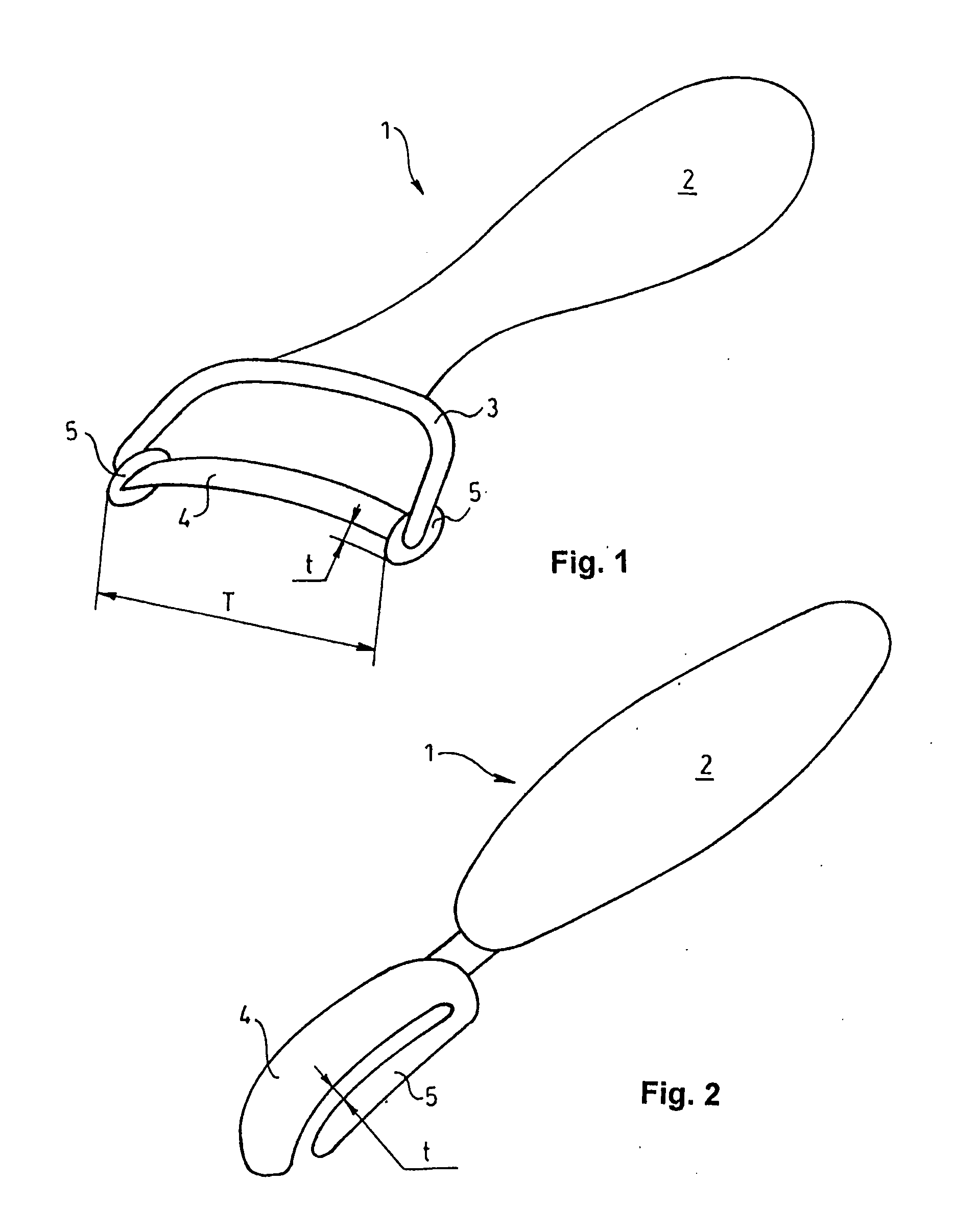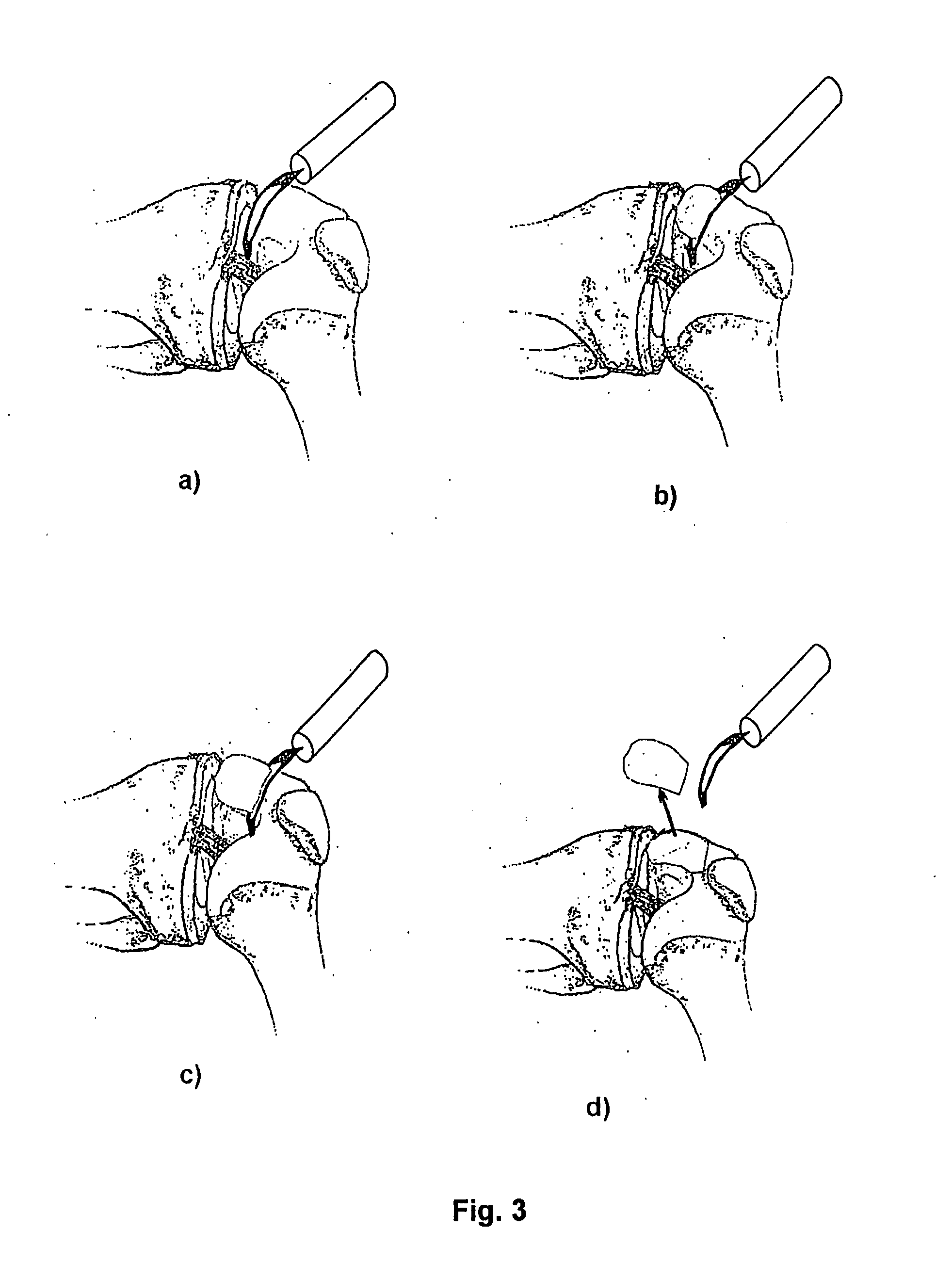Articular cartilage, device and method for repairing cartilage defects
a technology of cartilage and cartilage, applied in the field of articular cartilage for repairing cartilage defects, can solve the problems of insufficient treatment of medium or greater surfaces, insufficient simple biological reparation methods available for the time being, and insufficient long-term examination results, so as to achieve optimal structure and improve the efficiency of their use
- Summary
- Abstract
- Description
- Claims
- Application Information
AI Technical Summary
Benefits of technology
Problems solved by technology
Method used
Image
Examples
example 1
[0038]Several hundred milligrams of hyaline cartilage was collected with arthroscopy for repairing the cartilage damage of a young sportsman. The collected cartilage was delivered to a cell culturing laboratory.
[0039]After having obtained the required number of cells, they were suspended, poured onto the side of the matrix provided with incision, and left for properly sedimenting.
[0040]The cartilage matrix had been harvested in sterile conditions from the knee joint of a cadaver, long before the operation, with the device shown in FIG. 1. The matrix with a surface of 2×3 cm had been provided with incisions on the side facing the bone, with the device shown in FIG. 5. The incisions had been made in two perpendicular directions, wherein the distances between the incisions were 0.5 mm and the thickness of the intact collagen layer was 90 μm. The matrix had than been provided with a sterile packing and stored on a temperature of −80° C.
[0041]The cartilage matrix obtained from a cadaver ...
example 2
[0042]A patient of middle age had ankle complaints. As the result of an examination, it was found that he had focal cartilage defect on the upper surface of her talus. It was decided to perform cartilage substitution by cartilage cell transplantation, therefore bone marrow stem cells were collected for culturing (in cases, when it is not possible, joint cartilage particles may be collected for obtaining cells). The collected cells were delivered to a cell culturing laboratory.
[0043]Prior to the operation, cartilage sample had been harvested in sterile conditions from the knee joint of a cadaver, with the device shown in FIG. 2. The cartilage had been processed with incisions on the side facing the bone, with the device shown in FIG. 5. The incisions had been made in parallel directions, wherein the distances between the incisions were 0.8 mm and the thickness of the intact layer was 120 μm.
[0044]The multiplied cells were centrifuged to the graft provided with incisions, to be captur...
example 3
[0047]During arthroscopy of a women of middle age it was found that she had small cartilage deficiency on the knee joint. Therefore, at the same time, following a small joint exposure, the region of the cartilage deficiency has been cleared up to the healthy cartilage.
[0048]One week before the operation sound articular cartilage had been harvested in sterile conditions from the shoulder joint of a cadaver, with the device shown in FIG. 2. The cartilage had been provided with incisions on the side facing the bone. The incisions had been made in parallel directions, wherein the distances between the incisions were 0.1 mm and the thickness of the intact layer was 500 μm.
[0049]The cartilage had than been stored for one week in sterile conditions, without freezing, on +4° C., until the day of the operation.
[0050]The graft was delivered to the surgeon together with the living cells therein, for operation. A hole was made in the bone below the cartilage (microfracture) and the graft 14, af...
PUM
 Login to View More
Login to View More Abstract
Description
Claims
Application Information
 Login to View More
Login to View More - R&D
- Intellectual Property
- Life Sciences
- Materials
- Tech Scout
- Unparalleled Data Quality
- Higher Quality Content
- 60% Fewer Hallucinations
Browse by: Latest US Patents, China's latest patents, Technical Efficacy Thesaurus, Application Domain, Technology Topic, Popular Technical Reports.
© 2025 PatSnap. All rights reserved.Legal|Privacy policy|Modern Slavery Act Transparency Statement|Sitemap|About US| Contact US: help@patsnap.com



